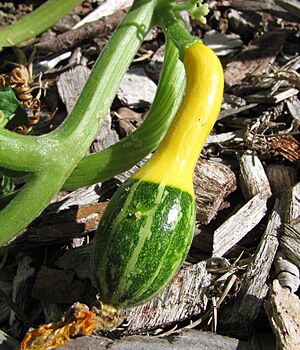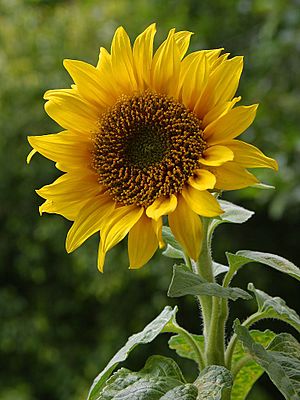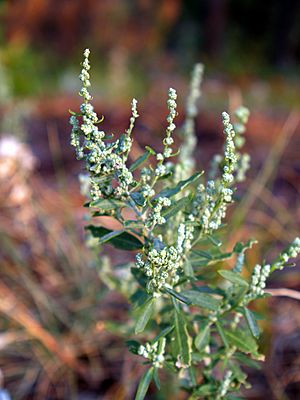Eastern Agricultural Complex facts for kids
The Eastern Agricultural Complex was a time when Native Americans in North America started farming. This happened around 1800 BCE. Before this, people mostly hunted animals and gathered wild plants for food. But then, they began to grow their own plants. This was one of about 10 places in the world where farming started independently.
The first four plants they grew were goosefoot, sunflower, marsh elder, and squash. Later, other plants were also farmed. Around 200 BCE, a new crop called maize (corn) came from Mexico. Slowly, Native Americans in the Eastern Woodlands started growing more maize. They began to grow fewer of their local plants, except for squash. The other plants eventually became wild again.
Contents
What is the Eastern Agricultural Complex?
The name "Eastern Agricultural Complex" (EAC) became popular in the 1940s. An expert named Ralph Linton used this term. He thought that tribes in the Eastern Woodlands learned about growing maize from people in Mexico. But they also had their own farming methods already.
Other experts, like Volney H. Jones and Melvin R. Gilmore, studied old cave sites. They found more proof of farming in places like Kentucky and the Ozark Mountains. Some people today think "indigenous seed crops" is a better name for this period.
Plants Grown in the EAC
Squash was one of the very first plants farmed in the Eastern Woodlands. It was found in the area about 7,000 years ago. But it might have been farmed there starting around 3,000 years ago. The early squash was grown for its edible seeds. It was also used to make small containers called gourds. It was not like the thick, fleshy squash we eat today. Other types of squash appeared later.
Other important plants of the EAC included:
- Little barley
- Goosefoot (also called lambsquarters)
- Erect knotweed
- Maygrass
- Sumpweed (or marsh elder)
- Sunflower
These plants are often put into two groups: "oily" or "starchy." Sunflowers and sumpweed have seeds rich in oil. Erect knotweed and goosefoot are starchy plants. Goosefoot also has edible leaves, like spinach. Maygrass and little barley are grasses. Their grains could be ground into flour.
How Plants Were Domesticated
Some plants that Native Americans farmed are now seen as unwanted weeds. For example, marsh elder is also called sumpweed. And chenopods are sometimes called pigweed. But a plant related to chenopods, called quinoa, is a popular health food. Many "weeds" are plants that grow quickly in disturbed soil. This happens after events like a fire or flood.
Experts like Bruce D. Smith studied how these plants became domesticated. Three of the main plants (chenopods, marsh elder, and squash) grew well in river valleys. After a flood, new, fertile soil appeared. These plants would grow quickly in large patches. But they often disappeared after one season, as other plants took over.
Native Americans soon learned that the seeds of these plants were good to eat. They were also easy to collect in large amounts. Squash was also useful because its gourds could be made into light containers. Chenopods have edible leaves, similar to spinach. Marsh elder seeds are oily and very nutritious.

When people gathered seeds, some would fall on the ground near their homes. These seeds would sprout and grow well in the sunny, disturbed soil. Over time, people started planting the seeds on purpose. They also cleared away other plants that would compete. The seeds that sprouted fastest and the plants that grew best were chosen. These were then harvested and replanted.
Through this process, the farmed plants became more productive. Their seeds often became larger. Also, their seed coats became thinner than those of wild plants. For example, farmed chenopodium seeds have very thin coats. Wild chenopodium seeds have much thicker coats. If Native Americans stopped growing these plants, their seeds would become thick again.
By about 500 BCE, seeds from six farmed plants were a big part of the diet. This was true for Native Americans in the middle Mississippi River valley.
The Arrival of Maize
Over time, the local crops were slowly replaced by more productive ones. These new crops came from what is now Mexico. They included maize (corn), beans, and new types of squash. Maize arrived later in the Eastern Woodlands. The oldest evidence of maize in Mexico is from 6700 BCE. In what is now Arizona and New Mexico, maize was grown by about 2100 BCE.
Maize was first grown by Eastern Woodlands cultures around 200 BCE. But it became widely used much later, around 900 CE. The spread was slow because the seeds and farming knowledge had to cross deserts and mountains. Also, new types of maize had to be developed. These new types needed to grow well in cooler climates and shorter growing seasons.
At first, maize was likely just an extra food source. But as it produced more food, it became the main crop. Eventually, maize-based farming completely replaced the Eastern Agricultural Complex. Most of the plants from the EAC are not grown today. Some, like little barley, are even considered weeds by modern farmers.
Images for kids





